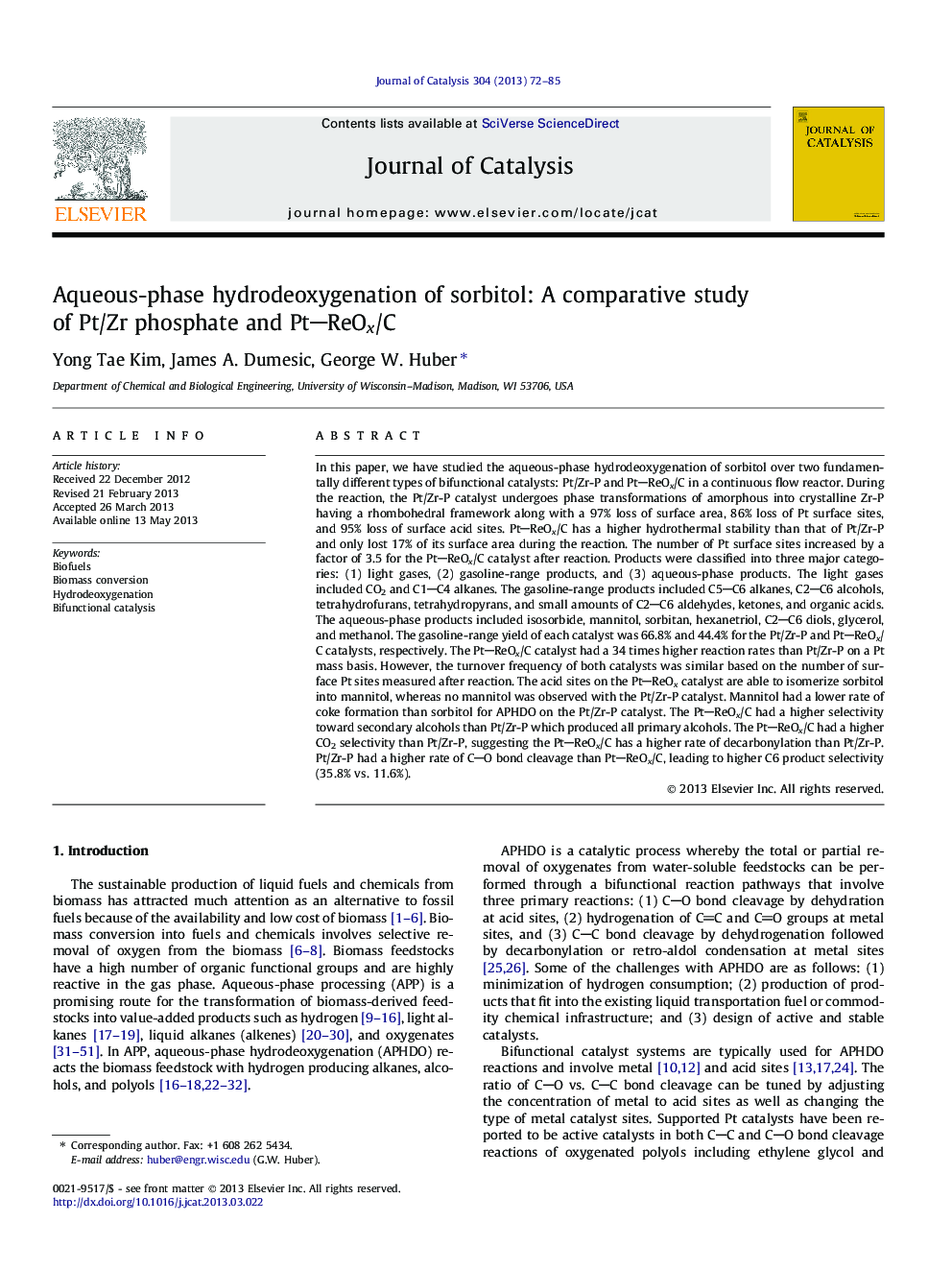| کد مقاله | کد نشریه | سال انتشار | مقاله انگلیسی | نسخه تمام متن |
|---|---|---|---|---|
| 61224 | 47570 | 2013 | 14 صفحه PDF | دانلود رایگان |

• Pt/Zr-P catalyst undergoes phase transformations of amorphous into crystalline Zr-P during aqueous-phase reactions.
• Turnover frequency of both catalysts was the almost same based on the number of surface Pt sites measured after reaction.
• The differences in product selectivity between the PtZr-P and PtReOx/C are related to the different acid–metal interaction.
In this paper, we have studied the aqueous-phase hydrodeoxygenation of sorbitol over two fundamentally different types of bifunctional catalysts: Pt/Zr-P and PtReOx/C in a continuous flow reactor. During the reaction, the Pt/Zr-P catalyst undergoes phase transformations of amorphous into crystalline Zr-P having a rhombohedral framework along with a 97% loss of surface area, 86% loss of Pt surface sites, and 95% loss of surface acid sites. PtReOx/C has a higher hydrothermal stability than that of Pt/Zr-P and only lost 17% of its surface area during the reaction. The number of Pt surface sites increased by a factor of 3.5 for the PtReOx/C catalyst after reaction. Products were classified into three major categories: (1) light gases, (2) gasoline-range products, and (3) aqueous-phase products. The light gases included CO2 and C1C4 alkanes. The gasoline-range products included C5C6 alkanes, C2C6 alcohols, tetrahydrofurans, tetrahydropyrans, and small amounts of C2C6 aldehydes, ketones, and organic acids. The aqueous-phase products included isosorbide, mannitol, sorbitan, hexanetriol, C2C6 diols, glycerol, and methanol. The gasoline-range yield of each catalyst was 66.8% and 44.4% for the Pt/Zr-P and PtReOx/C catalysts, respectively. The PtReOx/C catalyst had a 34 times higher reaction rates than Pt/Zr-P on a Pt mass basis. However, the turnover frequency of both catalysts was similar based on the number of surface Pt sites measured after reaction. The acid sites on the PtReOx catalyst are able to isomerize sorbitol into mannitol, whereas no mannitol was observed with the Pt/Zr-P catalyst. Mannitol had a lower rate of coke formation than sorbitol for APHDO on the Pt/Zr-P catalyst. The PtReOx/C had a higher selectivity toward secondary alcohols than Pt/Zr-P which produced all primary alcohols. The PtReOx/C had a higher CO2 selectivity than Pt/Zr-P, suggesting the PtReOx/C has a higher rate of decarbonylation than Pt/Zr-P. Pt/Zr-P had a higher rate of CO bond cleavage than PtReOx/C, leading to higher C6 product selectivity (35.8% vs. 11.6%).
The PtReOx/C catalyst was 34 times more active on a total Pt basis than the Pt/Zr-P for the conversion of sorbitol. However, both catalysts had comparable activities for the conversion of sorbitol based on the Pt surface sites measured after the reaction. Reaction condition: 518 K, 6.21 MPa with 20 wt% sorbitol solution as a feed, and flow rate of H2 is 40 mL min−1.Figure optionsDownload high-quality image (43 K)Download as PowerPoint slide
Journal: Journal of Catalysis - Volume 304, August 2013, Pages 72–85